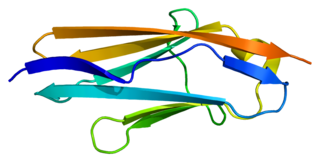
Peripherin is a type III intermediate filament protein expressed mainly in neurons of the peripheral nervous system. It is also found in neurons of the central nervous system that have projections toward peripheral structures, such as spinal motor neurons. Its size, structure, and sequence/location of protein motifs is similar to other type III intermediate filament proteins such as desmin, vimentin and glial fibrillary acidic protein. Like these proteins, peripherin can self-assemble to form homopolymeric filamentous networks, but it can also heteropolymerize with neurofilaments in several neuronal types. This protein in humans is encoded by the PRPH gene. Peripherin is thought to play a role in neurite elongation during development and axonal regeneration after injury, but its exact function is unknown. It is also associated with some of the major neuropathologies that characterize amyotropic lateral sclerosis (ALS), but despite extensive research into how neurofilaments and peripherin contribute to ALS, their role in this disease is still unidentified.

ROCK1 is a protein serine/threonine kinase also known as rho-associated, coiled-coil-containing protein kinase 1. Other common names are ROKβ and P160ROCK. ROCK1 is a major downstream effector of the small GTPase RhoA and is a regulator of the actomyosin cytoskeleton which promotes contractile force generation. ROCK1 plays a role in cancer and in particular cell motility, metastasis, and angiogenesis.

Polycystin-2(PC2) is a protein that in humans is encoded by the PKD2 gene.

TBK1 is an enzyme with kinase activity. Specifically, it is a serine / threonine protein kinase. It is encoded by the TBK1 gene in humans. This kinase is mainly known for its role in innate immunity antiviral response. However, TBK1 also regulates cell proliferation, apoptosis, autophagy, and anti-tumor immunity. Insufficient regulation of TBK1 activity leads to autoimmune, neurodegenerative diseases or tumorigenesis.

Serine/threonine-protein kinase Nek2 is an enzyme that in humans is encoded by the NEK2 gene.

Glucosidase 2 subunit beta is an enzyme that in humans is encoded by the PRKCSH gene.

Beta-casein is a protein that in humans is encoded by the CSN2 gene. It is in the class of phosphoproteins and generally occurs in mammalian milk.

C-jun-amino-terminal kinase-interacting protein 4 is a scaffold protein that in humans is encoded by the SPAG9 gene.

Serine/threonine-protein kinase Nek6 is an enzyme that in humans is encoded by the NEK6 gene.

Fasciculation and elongation protein zeta-1 is a protein that in humans is encoded by the FEZ1 gene.

Zinc finger protein 350 is a protein that in humans is encoded by the ZNF350 gene.

Serine/threonine-protein kinase Nek9 is an enzyme that in humans is encoded by the NEK9 gene.

Centrosome-associated protein CEP250 is a protein that in humans is encoded by the CEP250 gene. This gene encodes a core centrosomal protein required for centriole-centriole cohesion during interphase of the cell cycle. The encoded protein dissociates from the centrosomes when parental centrioles separate at the beginning of mitosis. The protein associates with and is phosphorylated by NIMA-related kinase 2, which is also associated with the centrosome. Furthermore, CEP135 is also required for the centriolar localization of CEP250.

Striated muscle preferentially expressed protein kinase, in the human is encoded by the SPEG gene, a member of the myosin light chain kinase protein family. SPEG is involved in the development of the muscle cell cytoskeleton, and the expression of this gene has important roles in the development of skeletal muscles, and their maintenance and function. Mutations are associated with centronuclear myopathies a group of congenital disorders where the cell nuclei are abnormally centrally placed.

Serine/threonine-protein kinase Nek3 is an enzyme that in humans is encoded by the NEK3 gene.

Serine/threonine-protein kinase MAK is an enzyme that in humans is encoded by the MAK gene.

G2/mitotic-specific cyclin-F is a protein that in humans is encoded by the CCNF gene.

Fasciculation and elongation protein zeta-2 is a protein that in humans is encoded by the FEZ2 gene.

Coiled-coil domain-containing protein 113 also known as HSPC065, GC16Pof6842 and GC16P044152, is a protein that in humans is encoded by the CCDC113 gene. The human CCDC113 gene is located on chromosome 16q21 and encodes 5,304 base pairs of mRNA and 377 amino acids.

Serine/threonine-protein kinase Nek8, also known as never in mitosis A-related kinase 8, is an enzyme that in humans is encoded by the NEK8 gene.























